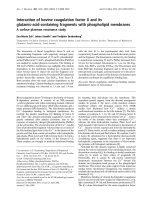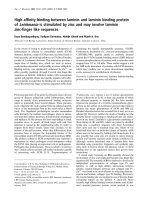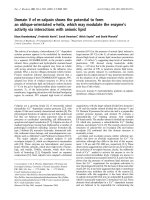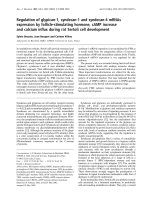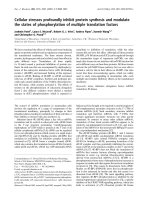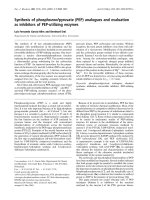Báo cáo y học: "International Retrovirology Association brings together scientists and clinicians to bridge discoveries about human " docx
Bạn đang xem bản rút gọn của tài liệu. Xem và tải ngay bản đầy đủ của tài liệu tại đây (261.26 KB, 5 trang )
BioMed Central
Page 1 of 5
(page number not for citation purposes)
Retrovirology
Open Access
Commentary
International Retrovirology Association brings together scientists
and clinicians to bridge discoveries about human T-lymphotropic
viruses from the laboratory to clinical trials
Edward Murphy
1
, Steven Jacobson
2
, Genoveffa Franchini
3
,
Graham P Taylor
4
, Barrie Hanchard
5
, Owen Morgan
5
and
Michael Lairmore*
6
Address:
1
Laboratory Medicine and Epidemiology/Biostatistics, University of California at San Francisco and Blood Systems Research Institute, San
Francisco, California, USA,
2
Viral Immunology Section, National Institute of Immunology and Neurological Diseases, National Institutes of
Health, Bethesda, Maryland, USA,
3
Animal Models & Retroviral Vaccines Section, National Cancer Institute, Bethesda, Maryland, USA,
4
Gastrointestinal and Urogenital Medicine and Communicable Diseases, Imperial College, Norfolk Place, London, United Kingdom,
5
Department
of Pathology and Medical Sciences, University of the West Indies, Kingston, Jamaica, West Indies and
6
Center for Retrovirus Research, Department
of Veterinary Biosciences, and Comprehensive Cancer Center, The Ohio State University, Columbus, Ohio, USA
Email: Edward Murphy - ; Steven Jacobson - ; Genoveffa Franchini - ;
Graham P Taylor - ; Barrie Hanchard - ;
Owen Morgan - ; Michael Lairmore* -
* Corresponding author
Abstract
Human T-lymphotropic virus type 1 (HTLV-1) and HTLV-2 were among the first human
retroviruses discovered in the early 1980's. The International Retrovirology Association is an
organized effort that fostered the efforts of scientists and clinicians to form interdisciplinary groups
to study this group of retroviruses and their related diseases. The Association promotes excellent
science, patient education, and fosters the training of young scientists to promote "bench-to-
bedside" research. The International Conference on Human Retrovirology: HTLV and Related Viruses
sponsored by the Association supports clinicians and researchers in the exchange of research
findings and stimulation of new research directions. This years conference will be held from June
22 to 25, in Montego Bay, Jamaica />. Since its inception in 1988,
these conferences have provided a highly interactive forum for the global community of HTLV
scientists. This is of particular importance as HTLV research enters its third decade and a new
generation of scientists takes over this important work. Many of the scientists attending the
meeting will be from developing countries where HTLV is endemic, consistent with the history of
international collaborations that have characterized HTLV research. The International Conference
on Human Retrovirology provides a unique opportunity for researchers of all disciplines interested
in HTLV infections to meet their peers and to address the questions facing clinicians and scientists
who study retroviruses, like HTLV.
Published: 29 March 2005
Retrovirology 2005, 2:22 doi:10.1186/1742-4690-2-22
Received: 22 March 2005
Accepted: 29 March 2005
This article is available from: />© 2005 Murphy et al; licensee BioMed Central Ltd.
This is an Open Access article distributed under the terms of the Creative Commons Attribution License ( />),
which permits unrestricted use, distribution, and reproduction in any medium, provided the original work is properly cited.
Retrovirology 2005, 2:22 />Page 2 of 5
(page number not for citation purposes)
Background
The International Retrovirology Association: Shared Vision
and Common Goals
Albert Einstein once said, "The problems that exist in the
world today cannot be solved by the level of thinking that
created them". This belief was part of the foundation of
The International Retrovirology Association when it was
established in May 1994. At that time, informal discus-
sions among established human T-lymphotropic viruses
(HTLV) scientists, representing such diverse disciplines as
epidemiology, virology, immunology, and clinical medi-
cine, came together at the 6
th
International HTLV Confer-
ence in Absecon, New Jersey, USA. This organized effort
from its beginning fostered the efforts of scientists and cli-
nicians to form interdisciplinary groups to study HTLV
and its related diseases in a cooperative and innovative
manner. With the growth of the conference over the next
decade (Table 1), the founders recognized that a profes-
sional association was needed to promote shared goals of
member scientists and to provide governance and conti-
nuity to the international conference and other activities.
The Association has evolved since these humble begin-
nings to now promote research and education in the field
of human retrovirology at the international level, includ-
ing scientific conferences, interdisciplinary research col-
laborations, and educational exchanges related to the
study of HTLV and related viruses. The Association has
chosen to focus on HTLV and other related human and
nonhuman primate retroviruses, in part, because numer-
ous other organizations and conferences already exist to
study human immunodeficiency virus (HIV). It strives to
promote excellent science in the field of HTLV and related
viruses and to facilitate the communication of scientific
results. The Association fosters the education and training
of young scientists who will contribute to and expand the
field. It promotes "bench-to-bedside" research that trans-
lates findings from the laboratory into clinical trials that
benefit HTLV-infected patients. Finally, it promotes
awareness of and education about HTLV and related
viruses to non-specialist physicians and the broader
public.
Discussion
HTLVs, Related Retroviruses and Disease Associations
Human T-lymphotropic virus type 1 (HTLV-1) and the
closely related HTLV-2 were among the first human retro-
viruses discovered in the early 1980's[1]. Both viruses are
highly related to simian T- lymphotropic viruses (STLV-1
and STLV-2, respectively), presumably from cross-species
transmissions of the simian viruses to humans. A recent
report of the discovery of two potentially novel, but
related HTLVs, indicate that cross species transmission
may still occur in situations where humans are exposed to
nonhuman primate blood[2]. Thus, in this context the
HTLVs are actually members of a broader group of pri-
mate T-lymphotropic viruses found worldwide. HTLV-1,
is classified as a member of the deltaretrovirus genera, and
infects approximately 15 to 20 million people around the
world[3]. HTLV-1 causes adult T cell leukemia/lymphoma
(ATLL), an aggressive malignancy of CD4+ T lymphocytes
in 1 to 5% of infected individuals and comes in a variety
of clinical presentations, but is refractory to most forms of
therapy[4]. The virus is also associated with a progressive
neurologic disease termed HTLV-1-associated myelopa-
thy/tropical spastic paraparesis (HAM/TSP) that affects
approximately the same number of infected subjects, but
rarely concurrent with ATLL[5]. HTLV-2 does not appear
to cause lymphoma or other hematological malignancy,
but has been associated with neurologic disease in a small
number of infected subjects, and may increase the suscep-
tibility to bacterial infections[6]. HTLV-1 is endemic in
Table 1: History of The International Conference on Human Retroviruses
Conference Month/Year Venue Attendance Host
I February/1988 Honolulu, Hawaii, USA 100 Dr. Diwan, University of Hawaii, USA
II March/1989 Port of Spain, Trinidad 114 University of West Indies, Trinidad and Tobago
III February/1990 Maui, Hawaii, USA 175 Dr. Diwan, University of Hawaii, USA
IV February/1991 Montego Bay, Jamaica 229 University of West Indies, Jamaica
V May/1992 Kumamoto, Japan 300 Kumamoto University, Japan
VI May/1994 Absecon, New Jersey, USA 375 Dr. Stanley Weiss, University Medicine and Dentistry of New Jersey,
Absecon, New Jersey, USA
VII October/1995 Paris, France 320 Drs. De The & A. Gessain, Institute Pasteur, Paris, France
VIII June/1997 Rio de Janeiro 344 Dr. Pombo de Oliveira, Instituto Nacional de Cancer, Brazil
IX April/1999 Kagoshima, Japan 366 Profs Osame and Sonoda, Kagoshima University, Japan
X June/2001 Dublin, Ireland 330 Prof. Hall, University College, Dublin, Ireland
XI June/2003 San Francisco, California 275 Prof. Murphy, University of California, San Francisco, USA
XII June/2005 Montego Bay, Jamaica 240* Prof. Hanchard & Prof. Owen Morgan, University of West Indies,
Jamaica
* Abstracts submitted in early registration
Retrovirology 2005, 2:22 />Page 3 of 5
(page number not for citation purposes)
Central Africa, the Caribbean, and South America likely
due to the slave trade, and southwestern Japan, while
HTLV-2 is endemic among Indian tribes of South, Central,
and North America. Both viruses may be transmitted from
mother to child mostly by breastfeeding, by sexual inter-
course, and by blood transfusion and the sharing of con-
taminated injection apparatus. Injection drug use, with
secondary sexual transmission, has resulted in the spread
of both HTLV-1 and HTLV-2 in the United States and
Europe. The potential contamination of HTLVs in the
blood supply makes them an important public health
issue in areas with high prevalence and has led many
countries including the United States and Japan to screen
normal blood donors for these viruses [7-9]. In addition,
the HTLVs serve as models for the epidemiology and
pathogenesis of other human retroviral infections such as
HIV.
An International Association to Promote Scientific
Exchange and Discovery
The International Retrovirology Association accomplishes
its goals through a variety of activities. Principally among
these is the sponsorship of its biennial general scientific
conferences held at rotating international venues, gener-
ally in areas with endemic HTLV infection. This unique
meeting brings together basic scientists, epidemiologists
and clinical researchers in a free form exchange of data to
discuss approaches to prevent HTLV infection or develop
new therapies against HTLV-mediated diseases. The Asso-
ciation also sponsors smaller symposia and regional
meetings directed at specific topics such as disease patho-
genesis, treatment of HTLV diseases and regional epidemi-
ology of this group of retroviruses. The group also honors
the contributions of leading scientists through endowed
awards to leaders in the HTLV research field and promotes
partnerships with professional journals to promote the
publication of HTLV research and conference proceed-
ings. By funding travel scholarships for the biennial con-
ference to young investigators the association encourages
the next generation of retrovirologists and physician-sci-
entists.
The International Conference on Human Retrovirology
HTLV and Related Viruses is a biennial conference that ful-
fills the continuing scientific need for the exchange of
research findings and stimulation of new research direc-
tions. Basic scientists who study the molecular biology of
HTLVs continue to grapple with the problem of how these
viruses cause cancer. They have discovered important
clues in this process by studying the viral gene product
called Tax, and other factors that support virus replication.
The conference also brings together those scientists that
seek to understand the pathogenesis of HAM/TSP, which
occurs presumably via aberrant immunologic response to
the viral infection. The immune-mediated nature of
HAM/TSP in infected subjects with particular HLA geno-
types suggest important host factors in understanding this
disease and provides a comparative model for other
neuro-immunologic diseases such as multiple sclerosis.
Clinicians and other scientists employing traditional and
molecular epidemiologic tools have been reasonably suc-
cessful at defining important public health issues related
to HTLV infections. These discoveries have led to
improved preventative measures to block mother to child
transmission, better confirmatory test strategies for blood
donor screening, and the prevention of HTLV-2 infection
among injection drug users[3]. Despite these advances
ongoing clinical and basic research is needed into poten-
tial HTLV-1 vaccines, and for improved treatments for
ATLL and HAM/TSP. The biennial HTLV conference serves
as an important stimulus for all of these research areas.
Conclusion
Jamaica Welcomes the International HTLV Conference in
2005
From June 22
nd
to 25
th
, 2005, the 12
th
International Confer-
ence on Human Retroviruses: HTLV and Related Viruses
meeting will be held in Montego Bay, Jamaica http://
www.htlvconference.org.jm/(Fig. 1). Since its inception in
1988, these conferences have provided a highly interactive
forum where the global community of HTLV researchers
presents their data at the only meeting devoted exclusively
to HTLV and related viruses. This is of particular impor-
Banner of the 12
th
International Conference on Human Retroviruses: HTLV and Related Viruses meeting to be held June 22 to 25, 2005 in Montego Bay, JamaicaFigure 1
Banner of the 12
th
International Conference on Human Retroviruses: HTLV and Related Viruses meeting to be held June 22 to 25,
2005 in Montego Bay, Jamaica.
Retrovirology 2005, 2:22 />Page 4 of 5
(page number not for citation purposes)
tance as HTLV research enters its third decade and a new
generation of scientists takes over the work of those who
started in this field. Many of the scientists attending the
meeting will be from developing countries where HTLV is
endemic, which is consistent with the history of
international collaborations that have characterized HTLV
research. Three hundred to 350 scholars from HTLV-
endemic regions and infectious disease research institutes
gather at this biennial meeting to present their latest data
on the molecular virology, immunology, epidemiology
and clinical outcomes of HTLV infection.
This year it is appropriate that the conference is held in
context to the 25
th
anniversary of the discovery of the first
identified human retrovirus, HTLV-1. HTLV-1 and HTLV-
2 infect a wide range of cells in cell culture. Recent reports
that indicate that Glut1, the major vertebrate glucose
transporter, acts as a HTLV receptor provides new and
exciting directions in research of the pathogenesis and
anti-viral therapy against HTLV-1[10,11]. Despite recent
advances in the management of lymphoproliferative dis-
eases ATLL remains difficult to treat with a median sur-
vival of 6 - 9 months. Better treatment is also needed for
the chronic and degenerative disorder now known as
HAM/TSP[12]. Although the molecular events of virus
replication are beginning to be unraveled and knowledge
about HTLV-1- and HTLV-2-associated diseases has
increased, many questions regarding the pathogenesis of
neurologic diseases associated with these retroviruses
remain. For example, it is unclear why some HTLV-1-
infected subjects develop ATLL or HAM/TSP, whereas the
majority of infected individuals remain disease free. More
puzzling is the role of these viruses in a number of other
inflammatory diseases associated with the HTLV-1 infec-
tion including uveitis, thyroiditis, polymyositis, alveolitis,
and infective dermatitis. Open questions remain about
how HTLV-1 targets and transforms CD4+ lymphocytes
and why HTLV-2, while apparently transforming for
CD8+ T-lymphocytes in culture is not clearly associated
with the devastating clinical disease linked to HTLV-1.
Data continue to emerge linking HTLV-1 infection with
some impairment of immune function that manifests as a
reduced ability to clear, despite therapy infections, certain
infections such as Strongyloides stercoralis, Schistosomia-
sis species, and Sarcoptes scabiei. Recent studies have pro-
vided important new roles for the non-structural viral
proteins of HTLVs e.g., p12
I
, p13
II
, and p30
II
, which con-
tinue to provide important clues into virus replication and
T-lymphocyte activation [13-15]. The continued discovery
of new, but related members of the deltaretrovirus family
of viruses raised intriguing questions regarding the origin
and transmission of human retroviruses.
The International Retrovirology Association through its
many varied approaches, including its international con-
ference, aims to encourage research in HTLV infections
and disease, foster collaborations between research
groups, provide a platform for critical analysis of new data
and contribute to the dissemination of knowledge about
these infections. While the biannual scientific meeting has
been the cornerstone of the Association's activities there is
increasing recognition of the need for more rapid progress
in improving the management of HTLV-associated malig-
nant and inflammatory diseases. The Association is ide-
ally positioned to facilitate this process through its
membership and the inclusion of a workshop on clinical
trials in ATLL and HAM/TSP in the program of the 12
th
International Conference on Human Retrovirology. Part-
nership between clinicians and scientists is key not only to
the development of clinical trials but also to pathogenesis
studies, which will inform the development of novel
interventions. The biannual conference provides a unique
opportunity for researchers of all disciplines interested in
HTLV infections to meet their peers and truly look beyond
their fields to elevate their "level of thinking" to address
the questions facing clinicians and scientists who study
retroviruses, like HTLV.
List of Abbreviations
HTLV, human T-lymphotropic viruses
HTLV-1, human T-lymphotropic virus type 1
HTLV-2, human T-lymphotropic virus type 2
HAM/TSP, HTLV-1-associated myelopathy/tropical spas-
tic paraparesis
ATLL, adult T-cell lymphoma/leukemia
Competing interests
The authors have no competing financial or other inter-
ests involved in the data, methods, or writing of this
manuscript.
Authors' contributions
Edward Murphy, Steven Jacobson, Genoveffa Franchini,
Graham P. Taylor, Barrie Hanchard, Owen Morgan and
Michael D. Lairmore have all met the definition of author
as outlined by the Retrovirology journal. Each has made
substantive intellectual contributions to the commentary.
Each author has given final approval of the version to be
published. Each author have participated sufficiently in
the work to take public responsibility for appropriate por-
tions of the content.
Acknowledgements
We thank Beverly Cranston for technical and logistic assistance in the
organization of the International Retrovirology Conference 2005, other
members of the conference organizing committee including Drs. Michie
Hisada (NIH), William Hall (University College, Dublin, Ireland), Mark
Publish with BioMed Central and every
scientist can read your work free of charge
"BioMed Central will be the most significant development for
disseminating the results of biomedical research in our lifetime."
Sir Paul Nurse, Cancer Research UK
Your research papers will be:
available free of charge to the entire biomedical community
peer reviewed and published immediately upon acceptance
cited in PubMed and archived on PubMed Central
yours — you keep the copyright
Submit your manuscript here:
/>BioMedcentral
Retrovirology 2005, 2:22 />Page 5 of 5
(page number not for citation purposes)
Beilke (Tulane University, New Orleans, LA, USA), and Steven Foung (Stan-
fored University, Stanford, CA, USA). We thank the National Institutes of
Health for R13 conference grants to support the International Retrovirol-
ogy Conference.
References
1. Gallo RC: The discovery of the first human retrovirus: HTLV-
1 and HTLV-2. Retrovirology 2005, 2:17.
2. Wolfe N, Heneine W, Carr JK, Garcia A, Shanmugam V, Tamoufe U,
Torimiro J, Prosser A, LeBreton M, Mpoudi-Ngole E, Mccutchan F,
Birx DL, Folks T, Burke DS, Switzer WM: Discovery of New
Human T-lymphotropic Viruses Reveals Frequent and
Ongoing Zoonotic Retrovirus Introductions: 2005/2/22. 12th
Conference on Retroviruses and Opportunistic Infections 2005 [http://
www.retroconference.org/2005/cd/Abstracts/25714.htm]. Boston,
Massachusetts, USA
3. Mahieux R, Gessain A: HTLV-1 and associated adult T-cell
leukemia/lymphoma. Rev Clin Exp Hematol 2003, 7:336-361.
4. Takatsuki K: Discovery of adult T-cell leukemia. Retrovirology
2005, 2:16.
5. Jacobson S: Immunopathogenesis of human T cell lympho-
tropic virus type I-associated neurologic disease. J Infect Dis
2002, 186 Suppl 2:S187-S192.
6. Orland JR, Wang B, Wright DJ, Nass CC, Garratty G, Smith JW,
Newman B, Smith DM, Murphy EL: Increased mortality associ-
ated with HTLV-II infection in blood donors: a prospective
cohort study. Retrovirology 2004, 1:4.
7. Anderson DC, Epstein J, Pierik L, Solomon J, Blattner W, Saxinger C,
Alter H, Klein H, McCurdy P, Nemo G, Kaplan J, Allen J, Khabbaz R,
Lairmore M: Licensure of screening tests for antibody to
human T-cell lymphotropic virus type I. Morb Mort Weekly
Report 1988, 37:736.
8. Khabbaz RF, Onorato IM, Cannon RO, Hartley TM, Roberts B,
Hosein B, Kaplan JE: Seroprevalence of HTLV-1 and HTLV-2
among intravenous drug users and persons in clinics for sex-
ually transmitted diseases. N Engl J Med 1992, 326:375-380.
9. Murphy EL, Fridey J, Smith JW, Engstrom J, Sacher RA, Miller K, Gib-
ble J, Stevens J, Thomson R, Hansma D, Kaplan J, Khabbaz R, Nemo
G, Williams AE, Nass C, Jackson CM, Ownby H, Kleinman S, Hutching
S, Busch MP, Evans C, Gilcher RO, Schreiber GB, Sacher R, Luban N,
Hollingsworth CG, Nemo GJ: HTLV-associated myelopathy in a
cohort of HTLV-I and HTLV- II- infected blood donors. Neu-
rology 1997, 48:315-320.
10. Manel N, Kim FJ, Kinet S, Taylor N, Sitbon M, Battini JL: The ubiqui-
tous glucose transporter GLUT-1 is a receptor for HTLV. Cell
2003, 115:449-459.
11. Kim FJ, Manel N, Garrido EN, Valle C, Sitbon M, Battini JL: HTLV-1
and -2 envelope SU subdomains and critical determinants in
receptor binding. Retrovirology 2004, 1:41.
12. Taylor GP: Pathogenesis and treatment of HTLV-I associated
myelopathy. Sex Transm Infect 1998, 74:316-322.
13. Michael B, Nair A, Lairmore MD: Role of accessory proteins of
HTLV-1 in viral replication, T cell activation, and cellular
gene expression. Front Biosci 2004, 9:2556-2576.
14. Michael B, Nair AM, Hiraragi H, Shen L, Feuer G, Boris-Lawrie K, Lair-
more MD: Human T lymphotropic virus type-1 p30II alters
cellular gene expression to selectively enhance signaling
pathways that activate T lymphocytes. Retrovirology 2004, 1:39.
15. Franchini G, Nicot C, Johnson JM: Seizing of T cells by human T-
cell leukemia/lymphoma virus type 1. Adv Cancer Res 2003,
89:69-132.




